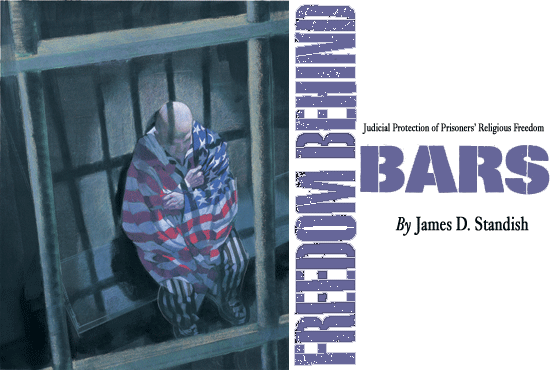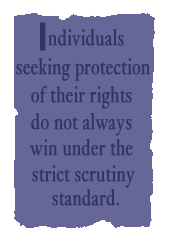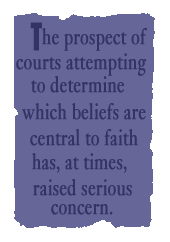Freedom Behind Bars
James D. Standish September/October 2003
Getting your Trinity Audio player ready...

Illustrations by Sally Wern Comport

One of the primary purposes of incarceration is the reform and eventual rehabilitation of prisoners.1 Despite this goal, recidivism is common, and prisons are often the breeding grounds of criminal conspiracies. Yet not all those released from prison return to a life of crime. For many, prison time provides the opportunity to reflect deeply on life and the impetus to explore religious faith. There is solid evidence that this exploration of faith plays an instrumental role in reforming prisoners.2
From the numerous examples of prisoners who have experienced a renewal through faith while incarcerated, some stories stand out. One such story is the life of Malcolm Little, who entered prison as a small-time crook, immersed in the world of drugs, prostitution, gambling, and theft. During his time in prison, however, Malcolm discovered Islam and, through Islam, a new understanding of his worth and potential. Ironically, he later stated that up until he was incarcerated he had "never been so truly free."3 Upon leaving prison, and after changing his name to Malcolm X, he abandoned his previous life of crime and went on to make a lasting contribution to the nation as a great thinker and leader.
Coming to prison from the other side of the tracks was Chuck Colson, fresh out of the Nixon White House. Despite their differences, Colson and Malcolm X have one important thing in common—they both went through a spiritual awakening while incarcerated. The reawakening not only led Colson to repent publicly for the crimes he had done, but redirected his life toward ministering to the needs of prisoners once he was released.
In between these rather remarkable stories of prison renewal there are thousands, hundreds of thousands, maybe even millions of prisoners who find spiritual meaning while incarcerated. Their names may not appear in the history books, and the views they adopt may not be as revolutionary, but the changes in their lives are just as profound. These men and women find a new sense of self-worth, a new meaning for their lives, and a new source of strength to draw upon to save them from their previous life of self-destruction and antisocial behavior. And if that isn't something our society should encourage, it would be hard to know what might be.
Protection of religion in prisons not only provides the utilitarian good of spurring reform, but is fundamental to upholding the Constitution. The purpose of the Bill of Rights is to protect unpopular minorities against the laws and actions of a state governed by the will and prejudices of the majority. There is probably no minority group as unpopular and powerless in today's society as prisoners. Therefore, there is no group whose rights to practice their faith need to be more jealously protected by the Constitution.
If religion is such a powerful force for achieving the penal system's goal of reform, and if the purpose of the Bill of Rights is to protect the freedoms of unpopular minorities such as prisoners, it would be expected that the prison system would do all that is feasible to create an environment in which religion flourishes, and that the courts would assiduously protect prisoners' religious freedom. But this is not always the case. In fact, during the past decade the legal protection of prisoners' religious freedom has gone through a rather dramatic series of ebbs and flows.
To understand these fluctuations, it is first necessary to be familiar with the approach courts take to protect rights guaranteed by the U.S. Constitution. The Supreme Court varies the test it uses to evaluate violations of constitutionally protected rights, depending on the right in question and the circumstances in which the right is expressed. The test that is used has a significant impact on the likelihood that the individual whose rights are in question will prevail. Thus while the Supreme Court has held that prisoners are protected by the First Amendment of the U.S. Constitution and therefore are afforded the right to practice their faith freely, the analysis courts apply to cases involving prisoners' religious practices determines the breadth of this right.

is provided through the application of "strict scrutiny" analysis. Under strict scrutiny analysis, courts require the state to demonstrate that it has a compelling interest for the regulation or action in question that inhibited the plaintiff's constitutionally protected freedom, and also to demonstrate that it used the least restrictive means to achieve that interest. If the state is unable to meet this two-pronged test, its interference with an individual's rights is held unconstitutional. Individuals seeking protection of their rights do not always win under the strict scrutiny standard, and the standard is somewhat susceptible to outcome-orientated manipulation; nevertheless, the parameters of the test do provide a reasonable balance between the rights of individuals and the needs to protect society against actions that may result in death, physical injury, and other similarly compelling societal concerns.
At the other end of the spectrum of protection is "rational basis" review. When courts review the inhibition of an individual's rights by the state under rational basis review, the court simply asks whether the inhibition was reasonably related to a legitimate governmental interest. When rational basis review is employed, the state almost always wins.
In 1987 in the O'Lone case the Supreme Court clearly outlined its approach to cases involving the restriction of prisoners' ability to practice their faith.4 The Court first recognized that inmates enjoy protection under the Constitution to practice their religion freely.5 It went on to state, however, that there is a necessary loss of rights when individuals are incarcerated because of both the realities of incarceration and valid penological objectives such as institutional security.6 The Court concluded that "in considering the appropriate balance of these factors, we have often said that evaluation of penological objectives is committed to the considered judgment of prison administrators
. . . we have determined that prison regulations alleged to infringe constitutional rights are judged under a 'reasonableness' test less restrictive than that ordinarily applied to alleged infringements of fundamental constitutional rights. . . . We recently restated the proper standard: 'When a prison regulation impinges on an inmate's constitutional rights, the regulation is valid if it is reasonably related to legitimate penological interest.'"7
Thus the Supreme Court in O'Lone applied rational basis review to prisoners' religious freedom claims. This standard is highly deferential to prison authorities and therefore provides precious little protection to inmates when their religious freedom is inhibited by prison regulation.

The Smith decision caused enormous concern among legislators, religious communities, and organizations that advocate the robust protection of religious freedom. In response to this concern, Congress passed the Religious Freedom Restoration Act (RFRA) in 1993. RFRA mandated that courts apply strict scrutiny analysis to free exercise of religion claims made under the U.S. Constitution, rather than the "neutral law of general applicability" test announced by the Supreme Court in Smith. During the period of RFRA's enforcement, courts used the strict scrutiny standard
in freedom of religion cases brought by all Americans, including those who were incarcerated.11
The period of RFRA's enforcement was relatively brief. In 1997 the Supreme Court found that RFRA violated the Constitution, at least as applied to the states.12 Thus when RFRA was struck down, federal protection of prisoners' rights in state institutions was dramatically reduced. In response to this decision, advocates for both the freedom of religion and the rights of the incarcerated began an intensive effort to pass legislation that would, among other things, increase the legal protection for prisoners to practice their faiths.
These efforts were successful. In September 2000 President Clinton signed the Religious Land Use and Institutionalized Persons Act of 2000 (RLUIPA). As its title suggests, RLUIPA focuses on protecting religious faiths from intrusive land use regulation and the protection of the right of institutionalized persons, including prisoners, to practice their faiths.
The first and most important aspect of RLUIPA in the context of prisons is the reinstatement of "strict scrutiny" analysis for free exercise of religion claims brought by prisoners. As previously noted, under strict scrutiny analysis the state must establish that it has a compelling state interest for inhibiting religious freedom, and must demonstrate that it acted in the least restrictive manner to achieve that interest. In prison, the state's compelling interest in security justifies a number of regulations that may inhibit religious practices. RLUIPA does not prevent such regulations, as long as they are narrowly tailored to meet the compelling interests. Thus there are a number of religious practices that the state may likely be able to prevent, even post RLUIPA. For example, the Sikh religion requires its adherents to carry a knife. It appears clear that in most prison environments, the carrying of a knife by inmates presents a serious security risk. Thus even after RLUIPA it is likely that courts will find that the inhibition of this religious practice passes constitutional muster.
Beyond reestablishing strict scrutiny analysis, RLUIPA defines the breadth of protected religious activity. RLUIPA's protection extends to the "exercise of religion, whether or not compelled by, or central to, a system of religious belief."13 This definition is quite broad, encompassing not only mandated actions, but all actions that are part of a religious faith. The definition not only provides protection for all religious practices, but also eliminates the necessity for courts to struggle to determine which actions are compelled and/or central to a petitioner's religious faith. The prospect of courts attempting to determine which beliefs are central to a faith has, at times, raised serious concern, particularly among some judicial scholars who view such a process as a dangerous entry of the state into religious affairs.
RLUIPA also alters the burden of proof prisoners must meet when they bring a claim based upon the violation of their
religious freedom. Under RLUIPA a prisoner must establish that their ability to practice their religion has been substantially impaired. Once this is established, the state has the burden to show that it has a compelling interest for impairing the prisoner's practice of their religion and that the state acted in the least restrictive means to achieve its compelling interest.14 This allocation of burdens is important, as it places the burden for each element of a claim under RLUIPA on the party in the best position to establish that element; the prisoner is best able to establish whether their religious free exercise has substantially been impaired, while the state is in the best position to establish what is, and what is not, in its compelling interest and how broad a rule is necessary to achieve that interest.
A final aspect of RLUIPA that is worth noting is that "the court, in its discretion, may allow the prevailing party" bringing a case to enforce RLUIPA "a reasonable attorney's fee as part of the costs."15 The ability of attorneys to recover the costs of successfully bringing cases to enforce RLUIPA increases the likelihood that such cases will be brought, and therefore prisoners' religious freedom will be actively supported.
There is some speculation whether RLUIPA will survive a challenge to its constitutionality, particularly in light of the successful challenge to RFRA. A number of challenges to the constitutionality of RLUIPA have already been filed. There are important distinctions between RLUIPA and RFRA, however, and these distinctions may save RLUIPA from RFRA's fate.
To understand the problem the Supreme Court found in RFRA, it is first important to understand that the federal government is limited in its ability to pass laws that are applicable to the states. A number of the justices that comprise the present Supreme Court have emphasized this limitation in recent cases. In so doing, they have interpreted the breadth of the powers provided to Congress by the Constitution to impose laws on the states more narrowly than some courts in the past.
One of the grants of power Congress enjoys under the Constitution is found in the Fourteenth Amendment. The Fourteenth Amendment, passed in the wake of the Civil War, extends the federal constitutional guarantees of due process and equal protection against actions not only of the federal government, but also the governments of the states.16 The Fourteenth Amendment specifically provides that "Congress shall have power to enforce, by appropriate legislation," the provisions of the Fourteenth Amendment.17 Congress relied upon this power when it passed RFRA. The Supreme Court, however, found that the power granted Congress under the Fourteenth Amendment could not be relied upon by Congress to justify the imposition of RFRA on the states. Thus RFRA was found unconstitutional, at least so far as it was applied to the states.
The drafters of RLUIPA, mindful of the Court's previous invalidation of RFRA, drafted RLUIPA accordingly. Rather than relying on the powers granted by the Fourteenth Amendment, the drafters relied on Congress's spending and the commerce powers.18 The spending power permits the federal government to regulate entities receiving federal money, and the commerce power permits the federal government to regulate interstate commerce. In order to act within these two powers, the drafters of RLUIPA limited its reach to burdens on religion "in a program or activity that receives Federal financial assistance; or . . . the substantial burden affects . . . commerce with foreign nations, among the several States, or with Indian Tribes."19
By relying on Congress's spending and commerce powers, and by limiting the scope of the act to activities that are covered by these powers, the drafters of RLUIPA avoided the pitfall of RFRA. Those attacking the constitutionality of RLUIPA claim, however, that the act relies on the spending and commerce powers in a way that is unconstitutional. It will be interesting to see if courts agree with these claims.
Some legal experts have suggested that RLUIPA may be unconstitutional for other reasons. For example, it has been suggested that RLUIPA, and RFRA before it, violate the separation of powers between the branches of government. It has also been claimed that RLUIPA violates the establishment clause of the Constitution because it favors religious activities over secular activities in an impermissible way.
It will be interesting to follow the various legal challenges to RLUIPA as they wind their way through the judicial system over the next few years. The way these cases are decided will determine, in many cases, whether or not prisoners' freedom to practice their faith is protected, or whether one of the most important ingredients of reform—an active growing faith—is denied those we incarcerate.
We are living through a time of tremendous flux in the level of judicial protection of religious freedom. For the time being, RLUIPA provides prisoners with relatively robust legal protection of this freedom. Such protection is laudable. It is in society's self-interest to protect the ability of prisoners to practice religion, as religious faith has a profound effect on reforming some prisoners. In addition, prisoners are just the sort of unpopular minority the Bill of Rights was designed to protect.
Maybe as important as any consideration in regard to prisoners' rights is that the greatness of a civilization is not judged by how it treats its most honorable citizens, but rather how it treats the least among it. While incarceration, by necessity, limits prisoners' rights, those basic human rights that can be protected should be. Prisoners should not be starved or treated harshly because of their race, they should not be tortured, and prisoners should be accorded the basic human right to find a faith and to practice that faith in every way possible under the circumstances. RLUIPA is a step in the direction of ensuring that this basic human dignity is afforded to the least of those among us. As such, it not only serves society's interest in providing opportunity for reform, but also ennobles the nation.

1 Kent Greenawalt—"Punishment," Encyclopedia of Criminal and Justice 4:1336, 1340, 1341 (1983), reprinted in Joshua Dressler, Cases and Materials on Criminal Law 25 (1994).
2 See, e.g., Byron R. Johnson, David B. Larson, and Timothy C. Pitts, "Religious Programs, Institutional Adjustment, and Recidivism Among Former Inmates in Prison Fellowship Programs," Justice Quarterly, p. 14 (March 1997).
3 Malcolm X, as told to Alex Haley, The Autobiography of Malcolm X (1965), p. 173.
4 O'Lone v. Estate of Shabazz, 482 U.S. 342 (1987).
5 Ibid., citing Cruz v. Beto, 405 U.S. 319 (1972).
6 O'Lone v. Estate of Shabazz, 482 U.S. 342 (1987).
7 Ibid.
8Ibid.
9Ibid.
10 Employment Division v. Smith, 494 U.S. 872 (1990).
11See, e.g., Alameen v. Coughlin, 892 F. Supp. 440 (E.D.N.Y. 1995); Allah v. Menei, 844 F. Supp. 1056 (E.D. Pa. 1994).
12 City of Boerne v. Flores, 521 U.S. 507 (1997). There is some disagreement over the impact of this case, with some believing it means that RFRA is unconstitutional as applied to all government action or laws, and others believing that RFRA is unconstitutional only as applied to the laws and actions of states and localities. It is certain that at the least, however, the federal RFRA no longer provides protection to the religious practices of prisoners in state and local facilities.
13 Religious Land Use and Institutionalized Persons Act of 2000, sec. 8 (7)(a).
14 Ibid., sec. 4(b).
15 Ibid., sec. 4(d), citing to 42 U.S.C. sec. 1988(b).
16 U.S. Constitution, Fourteenth Amendment, sec. 1.
17 Ibid., U.S. Constitution, Fourteenth Amendment, sec. 5.
18 Ibid., Article I, 8.
19 Religious Land Use and Institutionalized Persons Act of 2000, sec. 3(b).